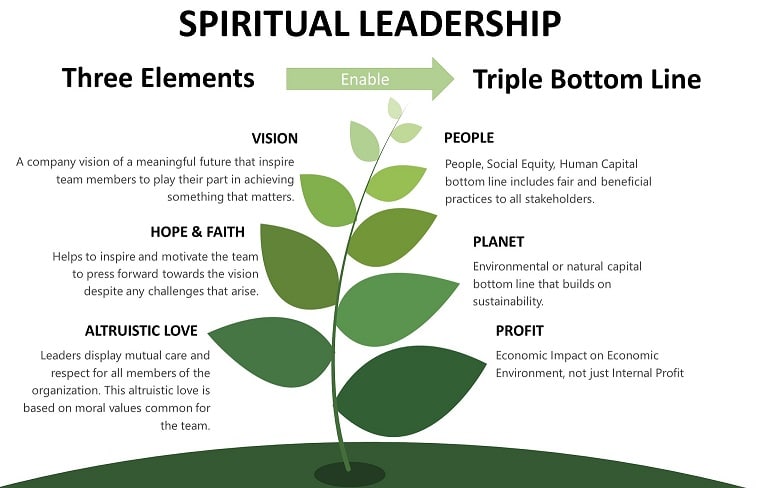Spiritual Leadership brings something new to the picture. The leadership theories we’ve discussed have neglected one crucial component, which spiritual leadership brings into effect. The missing item is altruistic love, and it’s often something we tend to ignore as we become absorbed with completing performance targets and saving the organization’s bottom line. This is where Spiritual Leadership is different, and it is something that I can learn from, as a CEO.
Spiritual Leadership is when Vision, Hope or Faith, and Altruistic love are integrated into the workplace to improve spiritual consciousness and provide employees with a more meaningful work experience.
Shifting the focus to altruistic love helps leaders appreciate that their teams want to do work they find meaningful, work that makes a difference. This thinking can improve the team’s intrinsic motivation and productivity. However, there is much more to spiritual leadership than altruistic love. Read this article to find out what spiritual leadership is all about.
What is Spiritual Leadership?
Louis Fry developed the concept of spiritual leadership in the early 2000s as a part of the intrinsic leadership theory. He explained the need for spiritual leadership in a 2008 journal article[1] entitled Spiritual Leadership: State-of-the-Art and Future Directions for Theory, Research, and Practice. Two justifications for spiritual leadership are presented in the article:
- Businesses are responding to global changes with a growing sense of spiritual consciousness
- Employees are actively looking for meaningful work experiences
Fry further states that these justifications led to an understanding of workplace spirituality. He cites the following definition from Giacalone and Jurkiewicz
[Workplace spirituality is] a framework of organizational values evidenced in the culture that promotes the employees’ experience of transcendence through the work process, facilitating their sense of being connected in a way that provides feelings of compassion and joy.
Workplace spirituality then forms the core of the spiritual leadership’s three defining features:
- Vision
- Hope/Faith
- Altruistic love
The component of altruistic love is a term coined by Pitirim Sorokin. As the founder of the Harvard Research Center in Creative Altruism, Sorokin believed that altruistic love extends beyond religious rituals. Instead, altruistic love is unselfish love based on the foundation of benevolence.
What Are the Fundamentals of Spiritual Leadership?
Spiritual leadership builds on three fundamentals, namely Vision, Hope/Faith and Altruistic Love. Each of them are described in more detail below this summary image.

Vision
Employees should believe that the company’s vision provides a meaningful future. Instead of focusing on the drudgery of completing routine tasks, employees will be inspired to play their part in achieving something that matters. The vision, therefore, should have broad appeal, clearly describe the final destination and the steps the organization will take to get there, and encourage hope and faith. There are some similarities with visionary leadership here. You can find visionary and many other styles in our leadership styles portal.
Hope/Faith
Leaders should be confident that the team is able to achieve the vision. This represents the hope/faith necessary to inspire the team to make the vision a reality and gives employees a sense that their life has meaning.
Hope and faith also give the motivation to press forward towards the vision despite the challenges that arise. Therefore, it’s a two-pronged element that involves being inspired by a meaningful vision and using that inspiration as the primary motivation to keep moving forward.
Altruistic Love
Employees expect leaders to display mutual care and respect for all members of the organization. This altruistic love is based on fundamental values that the team accepts to be morally right and that are modeled by spiritual leaders in their attitudes and behavior. (Refer to ethical leadership as well.)
These characteristics of spiritual leadership make it a valuable leadership style for supporting an organization’s triple bottom line – people, planet, and profit.
Spiritual leadership can also be viewed from two perspectives – personal and organizational. The personal perspective highlights inner life as its source where organizations recognize the spiritual needs of each employee. It also emphasizes personal spiritual leadership where the leader’s development is based on individual knowledge, the skills required for the role, and how the leader is able to impact followers to move in a particular direction.
The organizational perspective focuses on how everyone in the organization can work together to achieve meaningful objectives. The leader in this case is anyone within the organization who has a positive influence on the team’s calling, membership, and performance. It allows for both formal and informal leaders to play a role in the organization’s development.
This strong focus on the team members and their well-being is similar to Affiliative leadership, also available in our repository of leadership styles.
Develop yourself with these products from Leadershipahoy.com
What are the Pros and Cons of Spiritual Leadership?
Like all leadership styles, Spiritual leadership also has its advantages and disadvantages.
Advantages of Spiritual Leadership
1. Everyone feels like they belong
Spiritual leadership helps create a sense of belonging. This brings a sense of security and satisfaction which motivates employees to be productive. It also reduces employee turnover right thus saving the organization from overspending on constantly hiring new employees. Affiliative leadership can have a similar result.
2. Individuals are recognized for the work they do
Altruistic love creates room for individual recognition. A spiritual leader wants everyone to feel appreciated and will, therefore, put out the effort to recognize employees for their efforts.
3. Employee health can improve
It is believed that spiritual leadership can have a positive impact on people’s mental health and general life satisfaction. This in turn leads to a positive impact on physical health.
4. Corporate social responsibility is an important organizational objective
Altruistic love extends beyond the workplace and into the communities an organization serves. Emphasis on spiritual leadership ultimately leads to a greater focus on corporate social responsibility. Therefore, the organization will be more deliberate in supporting the needs of the community through environmental projects, volunteering in social projects, and giving back in other ways deemed relevant. This approach is touching on servant leadership which you can read more about in our leadership styles portal.

Disadvantages of Spiritual Leadership
1. Religious beliefs may seep in with this leadership style
Although spiritual leadership in the workplace isn’t necessarily based on religious beliefs, it is possible for some spiritual leaders to use their religious beliefs as a guide for the way they act. There is nothing inherently wrong with this until it becomes a case of the leader forcing his or her religious beliefs on employees. It is better for mutual respect for all employees’ religions to prevail in the workplace.
2. Loss of focus on business objectives
The spiritual feeling and focus might receive too much focus resulting in organizational and business targets being neglected as a consequence. The spiritual leader needs to balance well-being with performance and progress accordingly. Some pacesetting leadership might be useful to counter this. (Read more here: leadership styles.)
3. Too nice an environment
Just like in affiliative leadership, there is a risk that conflicts and feedback are swept under the rug in order to not disrupt the feeling of harmony in the team. This would result in unresolved issues which can grow and fester over time, leading to bitterness and resentment within the team.
4. Non-spiritual people might not fit in
Not everybody is spiritual. The high focus on spiritual areas can make others feel left out or shut out by others. Despite a strong spiritual orientation in an organization, there might still be a need for individuals who simply aren’t willing to participate in the spiritual side of things. A spiritual leader needs to make everybody feel welcome and part of the organization, even when it comes to non-spiritual people. This might mean influencing the organizational culture in that direction.
How Can You Be an Effective Spiritual Leader?
These are the skills you will need to develop if you want to become an effective spiritual leader.
Self Awareness
Spiritual leaders have high emotional intelligence. They understand their emotions and the emotions of others and can readily adjust their actions to prevent emotional conflicts with their team. Achieving this level of emotional intelligence requires paying attention to constructive criticism, observing the attitudes and behaviors of those around you, and continuous introspection. Read our article on empathy for additional tips. (Join our newsletter and get a free copy of our E-book “7 Tips on How to Improve Your Emotional Intelligence” by clicking here: Newsletter Emotional Intelligence E-book.)
Effective Communication
Each element of spiritual leadership depends heavily on the leader’s ability to effectively communicate. Gina Smith, Maria Minor, and Henry Brashen state that “effective communicators understand how to inspire a shared vision, challenge processes, enable others to act, and encourage the heart. Spiritual leaders are effective communicators since they must actively listen, clearly deliver ideas, and motivate.”[2] Learn from my list of communication tips for leaders if you are interested.
Promote Healthy Conflict
Spiritual leadership thrives in a work environment where openness is encouraged. It is important for everyone to be open and honest so that issues can be swiftly addressed, and healthy conflict can be encouraged. Consider using elements of democratic leadership to establish an open climate. (Article on democratic leadership available here: leadership styles.)
If you are sincere about improving as a leader, you might want to consider creating a leadership development plan. Learn more here: How to create a leadership development plan?
When does Spiritual Leadership Work Best?
Spiritual leadership is good for organizations where there is low employee morale and high tension. An effective spiritual leader can transform the work environment into one that is positive and conducive to the development of a strong team.
Furthermore, the spiritual leadership style can be very useful in environments where the cause is of greater importance than in the average organization. Nonprofit organizations and environmental organizations as well as others with an overarching cause might benefit from spiritual leadership.
Who Are Some Examples of Spiritual Leaders?
Barry Garapedian – Managing Director at Morgan Stanley
Barry Garapedian is one of the most well-known spiritual leaders in business[3]. His altruistic love is evident in how he approaches the holistic development of his employees; he encourages them to take time for their relationships, physical health, and spiritual well-being. Employees are then more motivated to be productive and help the organization meet its wealth creation objectives for clients.
This approach to leadership has helped him create a company that consistently receives high ratings for employee satisfaction, employee commitment, customer trust, community service, and wealth creation. Additionally, he uses an L-form (learning organization) spiritual leadership model where member engagement is paramount and all employees are encouraged to take part in learning, experimentation, and continuous improvement.
Julie Weber – Vice President and Chief People Officer at Southwest Airlines
In her role as Chief People Officer, Julie Weber has adopted a “hiring for attitude” motto for attracting the right talent to the company. Anyone hired by the company must display courage, perseverance, innovation, and a willingness to put others first. Their aim is to hire people who are already engaged and have values that align with those of the organization.
One of the strategies Weber and her team use to recognize employees who display the right values is the Winning Spirit Recognition program. According to Weber[4], this program “recognizes employees who deliver exceptional Southwest hospitality, display tremendous acts of courage, demonstrate outstanding teamwork, show heartfelt compassion or volunteer in their communities.”
Therefore, it’s not surprising that Southwest has a 4.5-star rating on TripAdvisor. Employees are clear about the organization’s values and vision and do their best to make that vision a reality.
Further Reading
I do recommend that you visit our leadership styles portal for additional useful leadership theories, such as the Situational Leadership Model, the Full Range Leadership Model, the Six Leadership Styles by Goleman, and many more.
References
http://what-when-how.com/love-in-world-religions/altruistic-love/
https://www.frontiersin.org/articles/10.3389/fpsyg.2018.02627/full#B28
https://iispiritualleadership.com/spiritual-leadership/#3
[1] https://www.researchgate.net/publication/304736788_Spiritual_Leadership_State-of-the-Art_and_Future_Directions_for_Theory_Research_and_Practice
[2] https://files.eric.ed.gov/fulltext/EJ1188325.pdf
[3] https://gbr.pepperdine.edu/2017/12/spiritual-leadership-learning-organization/
[4] https://www.thehrdigest.com/southwest-airlines-julie-weber-on-what-it-means-to-create-a-purpose-driven-culture/




